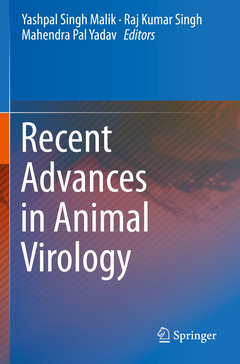Description
Recent Advances in Animal Virology, 1st ed. 2019
Coordinators: Malik Yashpal Singh, Singh Raj Kumar, Yadav Mahendra Pal
Language: English
Subjects for Recent Advances in Animal Virology:
Publication date: 11-2020
471 p. · 15.5x23.5 cm · Paperback
Publication date: 11-2019
471 p. · 15.5x23.5 cm · Hardback
Description
/li>Contents
/li>Biography
/li>Comment
/li>
Module 1_ Introduction.- Module 2_ Pox viruses.- Chapter 2.1. Background.- Chapter 2.2. History.- Chapter 2.3. Incidence and Prevalence.- Chapter 2.4. Diagnostic Techniques.- Chapter 2.5. Risk Factors.- Chapter 2.6. Transmission.- Chapter 2.7. Prevention & Control, References.- Module 3_Herpes viruses.- Chapter 3.1. Background.- Chapter 3.2. History.- Chapter 3.3. Incidence and Prevalence.- Chapter 3.4. Diagnostic Techniques.- Chapter 3.5. Risk Factors.- Chapter 3.6. Transmission.- Chapter 3.7. Prevention & Control, References.- Module 4_Papillomaviruses.- Chapter 4.1. Background.- Chapter 4.2. History.- Chapter 4.3. Incidence and Prevalence.- Chapter 4.4. Diagnostic Techniques.- Chapter 4.5. Risk Factors.- Chapter 4.6. Transmission.- Chapter 4.6. Prevention & Control, References.- Module 5_Adenoviruses.- Chapter 5.1. Background.- Chapter 5.2. History.- Chapter 5.3. Incidence and Prevalence.- Chapter 5.4. Diagnostic Techniques.- Chapter 5.5. Risk Factors.- Chapter 5.6. Transmission.- Chapter 5.7. Prevention & Control, References.- Module 6_Parvoviruses.- Chapter 6.1. Background.- Chapter 6.2. History.- Chapter 6.3.Incidence and Prevalence.- Chapter 6.4. Diagnostic Techniques.- Chapter 6.5. Risk Factors.- Chapter 6.6. Transmission.- Chapter 6.7. Prevention & Control, References.- Module 7_Circoviruses.- Chapter 7.1. Background.- Chapter 7.2. History.-Chapter 7.3. Incidence and Prevalence.- Chapter 7.4. Diagnostic Techniques.-Chapter 7.5. Risk Factors.-Chapter 7.6. Transmission.- Chapter 7.7. Prevention & Control, References.- Module 8_Reoviruses (Orbiviruses, Rotaviruses, Reovirus).- Chapter 8.1. Background.- Chapter 8.2. History.- Chapter 8.3. Incidence and Prevalence.- Chapter 8.4. Diagnostic Techniques.- Chapter 8.5. Risk Factors.- Chapter 8.6. Transmission.- Chapter 8.7. Prevention & Control, References.- Module 9_Birnaviruses.- Chapter 9.1. Background.- Chapter 9.2. History.- Chapter 9.3.Incidence and Prevalence.- Chapter 9.4. Diagnostic Techniques.- Chapter 9.5. Risk Factors.- Chapter 9.6. Transmission.- Chapter 9.7. Prevention & Control, References.- Module 10_Picobirnaviruses.- Chapter 10.1. Background.- Chapter 10.2. History.- Chapter 10.3. Incidence and Prevalence.- Chapter 10.4. Diagnostic Techniques.- Chapter 10.5. Risk Factors.- Chapter 10.6. Transmission.- Chapter 10.7. Prevention & Control, References.- Module 11_Rhabdoviruses.- Chapter 11.1. Background.- Chapter 11.2. History.- Chapter 11.3. Incidence and Prevalence.- Chapter 11.4. Diagnostic Techniques.- Chapter 11.5. Risk Factors.- Chapter 11.6. Transmission.- Chapter 11.7. Prevention & Control, References.- Module 12_Paramyxoviruses.- Chapter 12.1. Background.- Chapter 12.2. History.- Chapter 12.3. Incidence and Prevalence.- Chapter 12.4. Diagnostic Techniques.- Chapter 12.5. Risk Factors.- Chapter 12.6. Transmission.- Chapter 12.7. Prevention & Control, References.- Module 13_Orthomyxoviruses.- Chapter 13.1. Background.- Chapter 13.2. History.- Chapter 13.3. Incidence and Prevalence.- Chapter 13.4. Diagnostic Techniques.- Chapter 13.5. Risk Factors.- Chapter 13.6. Transmission.- Chapter 13.7. Prevention & Control, References.- Module 14_Picornaviruses.- Chapter 14.1. Background.- Chapter 14.2. History.- Chapter 14.3. Incidence and Prevalence.- Chapter 14.4. Diagnostic Techniques.- Chapter 14.5. Risk Factors.- Chapter 14.6. Transmission.- Chapter 14.7. Prevention & Control, References.- Module 15_Coronaviruses.- Chapter 15.1.Background.- Chapter 15.2. History.- Chapter 15.3. Incidence and Prevalence.- Chapter 15.4. Diagnostic Techniques.- Chapter 15.5. Risk Factors.- Chapter 15.6. Transmission.- Chapter 15.7. Prevention & Control, References.-Module 16_Flaviruses.- Chapter 16.1. Background.- Chapter 16.2.History.- Chapter 16.3. Incidence and Prevalence.- Chapter 16.4. Diagnostic Techniques.- Chapter 16.5. Risk Factors.- Chapter 16.6. Transmission.- Chapter 16.7. Prevention & Control, References.- Module 17_Equine viruses (Equine infectious Anaemia, West Nile, Equine Influenza).- Chapter 17.1. Background.- Chapter 17.2. History.- Chapter 17.3. Incidence and Prevalence.- Chapter 17.3. Diagnostic Techniques.- Chapter 17.4. Risk Factors.- Chapter 17.5. Transmission.- Chapter 17.6. Prevention & Control, References.- Module 18_Diagnostics.- Chapter 18.1. Background.- Chapter 18.2. Conventional Assays.- Chapter 18.3. Modern Assays.- Chapter 18.4. Future Questions.- Chapter 18.5. References.- Module 19_Vaccines.- Chapter 19.1. Background.- Chapter 19.1. Classical and modern approaches, Vaccine Administration.- Chapter 19.3. Mechanism of Action.- Chapter 19.4. Clinical Activity.- Chapter 19.5. Safety/Adverse Events.- Chapter 19.6. Future Questions.- Chapter 19.6. References.- Module 20_ Summary.
Dr Yashpal Singh Malik, is a “ICAR National Fellow” at the ICAR-Indian Veterinary Research Institute, Izatnagar, India. His work focuses on viral disease epidemiology, virus-host interactions, microbial biodiversity, characterization, and diagnosis of pathogens. He has completed training in Molecular Virology at University of Minnesota, USA and the Division of Virology, University of Ottawa, Ontario, Canada. He is a recipient of several prestigious national, state and academy awards and honors, including the ICAR-Jawaharlal Nehru Award. Has authored 5 books, 25 book chapters, and published 185 scientific research and review articles. Dr. Malik was the Editor-in-Chief of the Journal of Immunology Immunopathology and also edited special issues of “VirusDisease”, “The Open Virology Journal”, and “Journal of Current Drug Metabolism”.
Dr Raj Kumar Singh, is Director and Vice-Chancellor of the ICAR-Indian Veterinary Research Institute, Izatnagar. He is a respected scientist, specializing in veterinary microbiology, biotechnology, molecular epidemiology, diagnostics, and vaccinology. Dr Singh has served as Head, Division of Virology, Station-Incharge at IVRI, Mukteswar campus, Uttarakhand and later Director, NRC on Equines and VTCC, Hisar. Dr Singh has filed 10 national patents, two of which have been granted, and 14 live attenuated vaccines and 26 diagnostic tests and kits. He has authored 2 books, 23 book chapters and published over 234 scientific research papers, 52 Reviews, 15 Lead papers, and 24 Guest editorials/ compendium chapters. He has received several prestigious awards, including an FAO Fellowship for training at University of California Davis, USA. He is President of ISVIB, and has distinguished Fellowships and life memberships of prestigious professional societies.
Dr Mahendra Pal Yadav, is Former Director, ICAR-Indian Veterinary Research Institute, Izatnagar, and Vice-Chancellor, Sardar Vallabhbhai Patel UniversitThe book elucidates emerging & re-emerging viral diseases of livestock with colored representations for easy understanding of the reader
Chapter on vaccines and diagnosis provide updated information on new generation methodologies applicable in veterinary practice
Includes neglected viral diseases having relevance to livestock husbandry
These books may interest you

Animal-Origin Viral Zoonoses 168.79 €



